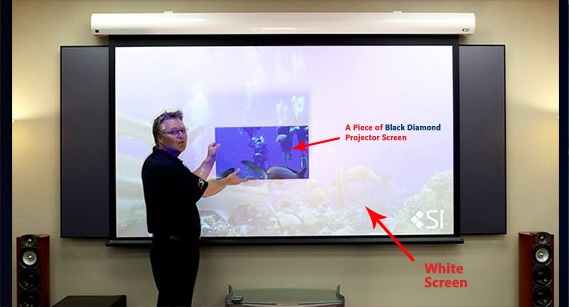Here’s a comparison of black vs white projector screen.
There are various ways of upgrading picture quality from a projector!
Nowadays it’s very easy to take the cinema out of the cinema hall and put it into the living room.
White screens for a projector are just an old standard.
But are they the only best choice?
I think “NO.”
History of Black (Gray) Screens
Do you know that the first gray screen named “Grayhawk” was introduced in 2001 by Stewart FilmScreen for the purpose of improving the picture quality?
Whether gray or black, using a dark screen for better picture quality is in practice for very long.
The dark screen became widely popular when Screen Innovations did something remarkable nearly six years ago by launching the Black Diamond projector screen.
But Black Diamond was a costly projector screen and average people couldn’t afford it.
So, years later one more projector screen was launched, the Slate.
It is an affordable version of the Black Diamond.
This article will discuss why and how you should choose a White or Dark screen depending on your projector and room.
Table of Contents
- White v/s Black Projector Screen – Which Is Best?
- Why Choose A Black Projector Screen
- Quick Overview – Pros & Cons
- Final Words
Now without any further ado, let’s get started.
Black vs White Projector Screen – Which is Best?
1. Contrast Ratio
The contrast ratio is defined as the difference between the white and dark portions of the image.
A black projector screen offers an excellent contrast ratio. It produces true black colors.
On the other hand, a white screen can also produce excellent contrast, but they need a projector with a high lumen count.
Generally, such projectors with a high lumen count are costly.
2. Visibility Of Bright Colors
Bright colors like yellow and green are very prominently visible on a black screen.
A screen with the highest contrast level is capable of doing so.
The green color on a white screen will look whitish but will be clearly visible on a black screen, as seen in the above image.
You can take yellow chalk and try writing on a whiteboard as well as on a blackboard to know what I am explaining.
3. True Blacks
As I said earlier, a black screen is exceptionally great at reproducing true black colors.
It possesses inherent darkness and impressive reflection properties.
The white screen doesn’t produce true blacks until you use it with high quality and costly projector having a high lumen.
4. Picture quality in the presence of the ambient light
A white screen works very similarly to that of a cinema hall. You need to make your room as dark as possible. You need black walls, ceiling, curtains, and closed doors to see the pictures clearly on a white screen.
And that’s the reality.
If you don’t have any problems with making everything black in your room, then a white screen is the best choice for you.
But if that’s not the case and you are about to use your projector in the presence of ambient light, then a black screen is good to go for you.
5. Reflectiveness
If you want a perfect cinematic feel in a fully dark room, then opting in for the black screen would work best.
Because we know that white reflects light and black absorbs light.
That is the reason we wear white in summer and black in winter.
A white screen will light up white walls and ceilings by reflecting the incident light.
So, with a white screen, you won’t get a real cinematic feel!
6. Viewing Angle
In the case of the viewing angle, the white screen dominates the black screen.
White screens have a wide viewing angle because they reflect light.
So you can see the screen clearly from any angle.
On the other hand, black screens do not reflect light, so you need to be in front of the screen for all the time.
7. Price
White screens are on the market for a very long.
The price of the white screen starts from $30-$50 and can go as high as $4,000.
In contrast to the white screen, the price of the black screen is high, and the availability is low.
You are supposed to get an excellent Black Screen for your projector at the price of $3,500 (minimum price).
So the price of the Dark Screen might surpass your budget, but we have a few reasons to explain buying a Black Screen over a White Screen,
Why Choose A Dark Screen
- If you want to experience high-quality HD movies at their best.
- If you are planning to use a projector in ambient light.
- You are willing to watch dark movies.
Final Words
Dark screens are the best choice but they are not affordable to everyone.
Finally, we will suggest,
#1 – If you are on a low budget, then go for the white screen without being confused between white and black screens.
#2 – If you have an intermediate budget then invest in a high-quality projector and choose a white screen.
Do not think that you won’t get excellent picture quality if you will not opt-in for a black screen. But the fact is white screens are proven for their quality over the past few decades.
#3 – If you think you have no budget limit and can spend significant money to convert your living room in a cinematic home theatre, don’t bother going for Black Screen. It is worth investing in!
